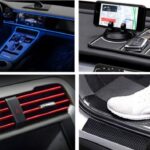

Automotive Prototypes: Making tomorrow’s cars possible
Introduction
In recent years, the automotive industry has undergone a revolutionary transformation, driven by advances in technology, consumer expectations, and a global shift toward sustainability. This transformation is largely driven by automotive prototypes, which are often seen as the forerunners of innovation. Rather than being merely conceptual, these cutting-edge prototypes embody the future of mobility. In this article, we examine the latest developments in automotive prototypes, highlighting their significance, technological advancements, and their potential impact on the automotive industry.
The Significance of Automotive Prototypes
A prototype serves as a bridge between the design and production phases of an automobile. Manufacturing companies use prototypes to test new concepts, technologies, and designs before committing to mass production.
Innovation testing is important for:
- Testing of Innovations: Advances in electrical power systems, unmanned driving technologies and next-gen infotainment are among the ideas that can be investigated through innovation tests.
- Design validation: Prototypes of vehicles enhance their good looks as well as ergonomics to ensure they comply with regulations and consumer tastes.
- Safety and performance: Prototyping makes sure new cars will pass tough safety requirements as well as have best possible performances.
- Feedback from the Market: Developing protos allows stakeholders like potential customers to give their opinions about final design inputs and features.
Technological Innovations in Automotive Prototypes
The latest automotive prototypes are a testament to the rapid advancements in technology. Key innovations include:
- Autonomous Driving: – Autonomous driving technology is one of the most transformative advancements in the automotive sector. Prototypes like the Waymo One and Tesla’s Full Self-Driving (FSD) Beta are at the forefront of this revolution. These vehicles are equipped with an array of sensors, cameras, and LIDAR systems, enabling them to navigate complex environments with minimal human intervention. The development of autonomous prototypes involves extensive testing under various conditions to ensure safety and reliability.
- Electric Powertrains: – Electric vehicles (EVs) are rapidly gaining traction as the automotive industry shifts towards sustainable mobility. Prototypes like the Lucid Air and Rivian R1T showcase cutting-edge electric powertrains with impressive ranges, fast charging capabilities, and high performance. Innovations in battery technology, such as solid-state batteries, are also being tested in these prototypes, promising longer ranges and shorter charging times.
- Advanced Materials and Manufacturing Techniques: – Prototypes often utilize advanced materials like carbon fiber composites and lightweight alloys to enhance performance and efficiency. Additive manufacturing, or 3D printing, is being used to create complex components with reduced weight and increased strength. These materials and techniques allow for greater design flexibility and faster iteration cycles, pushing the boundaries of automotive engineering.
- Connected and Smart Vehicles: – The integration of Internet of Things (IoT) technologies in automotive prototypes is paving the way for connected and smart vehicles. These prototypes feature advanced connectivity solutions, enabling vehicle-to-vehicle (V2V) and vehicle-to-infrastructure (V2I) communication. This connectivity enhances safety, traffic management, and provides a seamless driving experience. Prototypes like the Audi A8 with Car-to-X technology demonstrate the potential of connected vehicles in real-world applications.
Impacts on the Automotive Sector
Innovations in cutting-edge prototypes of automobiles are projected to have a deep effect on the automotive industry. Key areas of influence include:
- Sustainability: – Electric and hybrid vehicle models are driving the change for greener transportation. These vehicles help in reducing emissions and reliance on fossil fuels that contributes to global efforts towards mitigating climate change. Furthermore, these vehicles use sustainable materials and manufacturing processes thereby further enhancing environmental benefits.
- Safety and Reliability: – Autonomous driving prototypes and advanced driver-assistance systems (ADAS) enhance vehicle safety by minimizing human error. Advanced safety features such as adaptive cruise control, lane-keeping assist, automated emergency braking are increasingly becoming standard equipment making driving safer for everyone.
- Consumer Experience: – Prototypes with advanced infotainment systems, augmented reality displays, and personalized user interfaces are redefining the in-car experience. These advances meet an increasing demand for connectivity, entertainment and convenience thereby leading to customer satisfaction as well as loyalty.
- Market Dynamics: – The introduction of ground-breaking prototypes can alter market dynamics through setting new benchmarks for performance, safety, and sustainability. Companies that lead in prototype innovation often gain a competitive edge, attracting early adopters and establishing themselves as industry leaders.
Case Studies of Cutting-Edge Prototypes
1. Tesla Cybertruck
The Tesla Cybertruck is a striking example of a cutting-edge automotive prototype that has captured global attention. Its futuristic design, robust performance, and advanced features, such as adaptive air suspension and bulletproof glass, make it a standout in the electric truck segment. The Cybertruck showcases Tesla’s commitment to pushing the boundaries of design and engineering.
2. Mercedes-Benz EQS
The Mercedes-Benz EQS is an all-electric luxury sedan that embodies the future of electric mobility. With a range of over 400 miles, rapid charging capabilities, and a luxurious interior featuring the MBUX Hyperscreen, the EQS sets new standards for electric vehicles. Its aerodynamic design and sustainable materials further highlight Mercedes-Benz’s dedication to innovation and sustainability.
3. BMW iX
The BMW iX is an electric SUV prototype that represents BMW’s vision for the future of mobility. It features a minimalist design, a high-tech interior, and advanced driver assistance systems. The iX’s focus on sustainability is evident in its use of recycled materials and its efficient electric powertrain, making it a strong contender in the electric SUV market.
Future Trends and Challenges
As automotive prototypes continue to evolve, several trends and challenges will shape the future of the industry:
- Integration of Artificial Intelligence: – AI will play a crucial role in the development of autonomous and connected vehicles. From predictive maintenance to personalized user experiences, AI-driven features will become more prevalent in future prototypes.
- Regulatory and Ethical Considerations: – The rapid advancement of autonomous and connected vehicle technologies raises important regulatory and ethical questions. Ensuring that these vehicles operate safely and ethically will require robust regulatory frameworks and ongoing dialogue between industry stakeholders, policymakers, and the public.
- Infrastructure Development: – The success of electric and autonomous vehicles hinges on the development of supporting infrastructure, such as charging stations and smart road systems. Investment in infrastructure will be critical to the widespread adoption of these advanced vehicles.
- Consumer Acceptance: – While technological advancements are impressive, consumer acceptance will ultimately determine the success of new automotive prototypes. Manufacturers must address concerns related to safety, privacy, and reliability to build trust and encourage adoption.
Conclusion
Cutting-edge automotive prototypes are at the forefront of the industry’s transformation, embodying the innovations that will shape the future of mobility. From autonomous driving and electric powertrains to advanced materials and connected technologies, these prototypes are paving the way for safer, more efficient, and sustainable vehicles. As the industry continues to evolve, the role of prototypes in testing, validating, and refining new concepts will remain crucial, driving the automotive world towards a smarter and greener future.
Add a comment Cancel reply
Comments (0)
Categories
- Article (11)
- Auto Detailing (1)
- Car News (2)
- Car Reviews (1)
Recent Posts
About us

Related posts


Upcoming SUV in 2025 in India: Most Anticipated Launches You Can't Miss!
![🚗 Tata Punch Price in Gurgaon [2025 Updated] – Best On Road Offers!](https://carblogs.in/wp-content/uploads/2025/04/Tata-Punch-Price-in-Gurgaon-335x186.webp)
🚗 Tata Punch Price in Gurgaon [2025 Updated] – Best On Road Offers!





![🚗 Tata Punch Price in Gurgaon [2025 Updated] – Best On Road Offers!](https://carblogs.in/wp-content/uploads/2025/04/Tata-Punch-Price-in-Gurgaon-150x150.webp)



